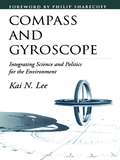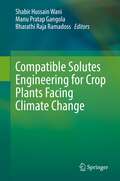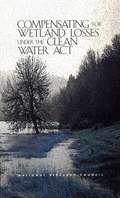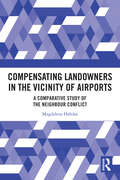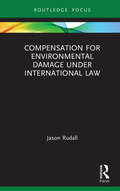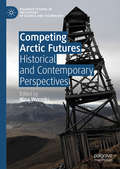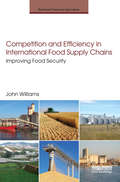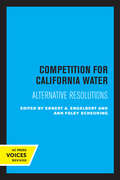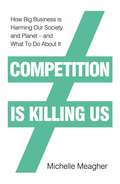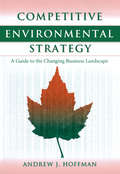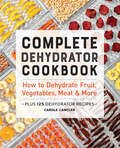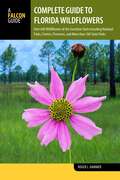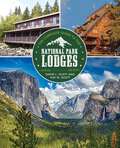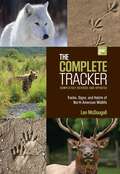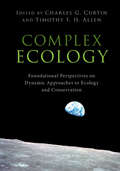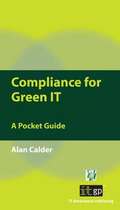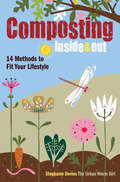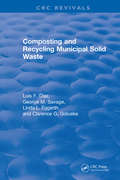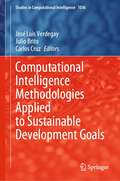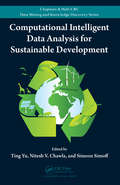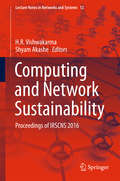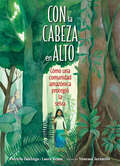- Table View
- List View
Compartmental Distribution Of Radiotracers (CRC Press Revivals)
by Lelio G. Colombetti James S. RobertsonThe availability of isotopic varieties of the chemical elements has had a strong impact on many branches of science. For some procedures isotopic tracers make possible methods that are simply easier or more accurate or more convenient than other methods. More importantly, however, there are some processes, particularly those involving steady-state conditions, that before the advent of isotopic tracers were considered to be not accessible to investigation, but which can be studied with these tracers. In biological studies the radioactive tracers have been especially useful because external detection methods can be employed in noninvasive or minimally invasive studies.
Compass and Gyroscope: Integrating Science And Politics For The Environment
by Philip Shabecoff Kai N. LeeUsing the Columbia River Basin in the Pacific Northwest as a case study, Kai Lee describes the concept and practice of "adaptive management," as he examines the successes and failures of past and present management experiences. Throughout the book, the author delves deeply into the theoretical framework behind the real-world experience, exploring how theories of science, politics, and cognitive psychology can be integrated into environmental management plans to increase their effectiveness.
Compatible Solutes Engineering for Crop Plants Facing Climate Change
by Shabir Hussain Wani Manu Pratap Gangola Bharathi Raja RamadossPlants, being sessile and autotrophic in nature, must cope with challenging environmental aberrations and therefore have evolved various responsive or defensive mechanisms including stress sensing mechanisms, antioxidant system, signaling pathways, secondary metabolites biosynthesis, and other defensive pathways among which accumulation of osmolytes or osmo-protectants is an important phenomenon. Osmolytes with organic chemical nature termed as compatible solutes are highly soluble compounds with no net charge at physiological pH and nontoxic at higher concentrations to plant cells. Compatible solutes in plants involve compounds like proline, glycine betaine, polyamines, trehalose, raffinose family oligosaccharides, fructans, gamma aminobutyric acid (GABA), and sugar alcohols playing structural, physiological, biochemical, and signaling roles during normal plant growth and development. The current and sustaining problems of climate change and increasing world population has challenged global food security. To feed more than 9 billion, the estimated population by 2050, the yield of major crops needs to be increased 1.1–1.3% per year, which is mainly restricted by the yield ceiling. A major factor limiting the crop yield is the changing global environmental conditions which includes drought, salinity and extreme temperatures and are responsible for a reduction of crop yield in almost all the crop plants. This condition may worsen with a decrease in agricultural land or the loss of potential crop yields by 70%. Therefore, it is a challenging task for agricultural scientists to develop tolerant/resistant varieties against abiotic stresses. The development of stress tolerant plant varieties through conventional breeding is very slow due to complex multigene traits. Engineering compatible solutes biosynthesis by deciphering the mechanism behind the abiotic tolerance or accumulation in plants cell is a potential emerging strategy to mitigate adverse effects of abiotic stresses and increase global crop production. However, detailed information on compatible solutes, including their sensing/signaling, biosynthesis, regulatory components, underlying biochemical mechanisms, crosstalk with other signaling pathways, and transgenic development have not been compiled into a single resource. Our book intends to fill this unmet need, with insight from recent advances in compatible solutes research on agriculturally important crop plants.
Compensating For Wetland Losses Under The Clean Water Act
by Committee on Mitigating Wetland LossesRecognizing the importance of wetland protection, the Bush administration in 1988 endorsed the goal of “no net loss” of wetlands. Specifically, it directed that filling of wetlands should be avoided, and minimized when it cannot be avoided. When filling is permitted, compensatory mitigation must be undertaken; that is, wetlands must be restored, created, enhanced, and, in exceptional cases, preserved, to replace the permitted loss of wetland area and function, such as water quality improvement within the watershed. After more than a dozen years, the national commitment to “no net loss” of wetlands has been evaluated. This new book explores the adequacy of science and technology for replacing wetland function and the effectiveness of the federal program of compensatory mitigation in accomplishing the nation’s goal of clean water. It examines the regulatory framework for permitting wetland filling and requiring mitigation, compares the mitigation institutions that are in use, and addresses the problems that agencies face in ensuring sustainability of mitigated wetlands over the long term. Gleaning lessons from the mixed results of mitigation efforts to date, the book offers 10 practical guidelines for establishing and monitoring mitigated wetlands. It also recommends that federal, state, and local agencies undertake specific institutional reforms. This book will be important to anyone seeking a comprehensive understanding of the “no net loss” issue: policy makers, regulators, environmental scientists, educators, and wetland advocates.
Compensating Landowners in the Vicinity of Airports: A Comparative Study of the Neighbour Conflict
by Magdalena HabdasThe purpose of this book is to consider the neighbour conflict arising between airports and neighbouring owners of land, particularly with residential uses, as well as to assess the existing solutions applied to manage or resolve that conflict. The book explains why the neighbour conflict between the airport and landowners is of a particular kind and what legal instruments are applied to resolve it in an attempt to balance the interests of opposing parties. Readers will develop an understanding of how the law operates when damage is caused by a legal act of the government and what the limits of compensable loss are. In addition, the reader will discover the economic foundations of possible solutions and why not all market losses are legally compensable. Key features of this book include: • a consideration of key legal concepts such as neighbour law, nuisance, protection of property, land use restrictions, liability, and compensation to inform a unique analysis of neighbour law in the context of conflict between airports and neighbouring landowners • practical guidance on an airport’s legal liability towards neighbouring landowners • a comparative analysis of airport’s liability, compensation claims, their scope and economic effects • a comparative overview of planning and environmental solutions applied in a variety of jurisdictions • discussion of valuation methods and challenges when loss of property value is the measure of compensation The author’s intention is to promote conscious and civil relations among market participants, as opposed to opportunistic and speculative behaviour. This book is important reading for lawyers, academics, PhD students, and postgraduate students dealing with land use regulations, environmental law, compulsory purchase, eminent domain and expropriation issues and compensation for property restrictions, as well as with aviation law and legal aspects of airport operations.
Compensation for Environmental Damage Under International Law (Routledge Research in International Environmental Law)
by Jason RudallInspired by recent litigation, this book identifies and critically appraises the manifold and varied approaches to calculating compensation for damage caused to the environment. It examines a wide range of practice on compensation – in general and specifically for environmental damage – from that of international courts and tribunals, as well as international commissions and regimes, to municipal approaches and other disciplines such as economics and philosophy. Compensation for Environmental Damage Under International Law synthesises these approaches with a view to identifying their blind spots, bringing clarity to an area where there exists broad discrepancy, and charting best practices that appropriately balance the manifold interests at stake. In particular, it is argued that best practice methodologies should ensure compensation serves to fully repair the environment, reflect the emerging ecosystems approach and any implications environmental damage may have for climate change, as well as take into account relevant equitable considerations. This book is essential reading for academics, practitioners and students working in the field of environmental law.
Competing Arctic Futures: Historical and Contemporary Perspectives (Palgrave Studies in the History of Science and Technology)
by Nina WormbsThis edited collection explores how narratives about the future of the Arctic have been produced historically up until the present day. The contemporary deterministic and monolithic narrative is shown to be only one of several possible ways forward. This book problematizes the dominant prediction that there will be increased shipping and resource extraction as the ice melts and shows how this seemingly inevitable future has consequences for the action that can be taken in the present. This collection looks to historical projections about the future of the Arctic, evaluating why some voices have been heard and championed, while others remain marginalised. It questions how these historical perspectives have shaped resource allocation and governance structures to understand the forces behind change in the Arctic region. Considering the history of individuals and institutions, their political and economic networks and their perceived power, the essays in this collection offer new perspectives on how the future of the Arctic has been produced and communicated.
Competition and Efficiency in International Food Supply Chains: Improving Food Security (Earthscan Food and Agriculture)
by John WilliamsWhy have food crises seemingly become more frequent in recent years, compared to the last few decades? This book examines an array of different issues and distortions that are causing food supply chain dysfunction in many countries, particularly for staple non-perishable foods such as grains, oilseeds, pulses and sugar. It outlines the underlying changes that are currently occurring, which will have an influence on the direction of future food supply chains, and provides some solutions to current food security problems. Based on an analysis of total regulation in the 1950s-60s through to deregulation during the 1980-90s, as well as post-deregulation, it focuses on liberal trade and deregulation as a more successful solution to creating efficiencies in food supply chains and distribution. The author highlights a common thread of either farmers using government for vested-interest intervention, or autocratic governments seeking market and supply-chain power. The book examines the role of government after 70 years of food supply chain intervention. It discusses the role of commercial ‘trade’ markets and cluster industries and how these can quickly disintegrate when price distortions occur. The author studies both food importing and exporting countries and concludes that comingled commoditization of food has led to increased hoarding, corruption, and dependence on food aid. He argues that a competitive food supply chain that has minimum intervention is more likely to provide future food security. In conclusion the book emphasizes that adequate rewards, competition, and striving for supply chain efficiencies are the essences of sustainable food security.
Competition for California Water: Alternative Resolutions
by Ernest A. Engelbert Ann Foley ScheuringCalifornia’s water is at the center of an intense economic and political struggle. A balance between supply and demand must be reached, but it is far from certain that all Californians will get as much water as they want at a price they feel is right. Competition for California Water presents essential information on key issues, including: Costs: What would be the yields and what would be the costs, in dollars as well as less tangible values, of developing new sources of water? Cost-sharing: How much of the cost of water development and distribution should be borne by the general public, and how much by water users and other beneficiaries? Environmental protection: To what extent should environmental values be protected? Conservation: To what extent can the need for new water development be offset by conservation and more efficient use of water? Institutional reform: Can changes in the laws and institutions of California produce a more efficient system of water supply and management? Agriculture: How much increase in cost and/or loss of water can California agriculture bear and still remain competitive? Thirty-one experts on all aspects of this topic project alternative futures for California’s water supply. Written in nontechnical language, Competition for California Water is an invaluable source of information for Californians concerned with the future of their state.This title is part of UC Press's Voices Revived program, which commemorates University of California Press’s mission to seek out and cultivate the brightest minds and give them voice, reach, and impact. Drawing on a backlist dating to 1893, Voices Revived makes high-quality, peer-reviewed scholarship accessible once again using print-on-demand technology. This title was originally published in 1982.
Competition is Killing Us: How Big Business is Harming Our Society and Planet - and What To Do About It
by Michelle MeagherWe live in the age of big companies where rising levels of power are concentrated in the hands of a few. Yet no government or organisation has the power to regulate these titans and hold them to account. We need big companies to share their power and we, the people of the world, need to reclaim it. In Competition is Killing Us, top business and competition lawyer Michelle Meagher establishes a new framework to control capitalism from the inside in order to make it work for the many and not just the few. Meagher has spent years campaigning against these multi-billion and trillion dollar mammoths that dominate the market and prioritise shareholder profits over all else; leading to extreme wealth inequality, inhumane conditions for workers and relentless pressure on the environment.In this revolutionary book, she introduces her wholly-achievable alternative; a fair and comprehensive competition law that limits unfair mergers, enforces accountability and redistributes power through stakeholder governance.
Competitive Environmental Strategy: A Guide To The Changing Business Landscape
by Andrew J. HoffmanEnvironmental concerns can greatly affect business success, regardless of whether a business person or corporation shares those concerns. Today's corporate managers must understand the power of environmental issues, and shift their mindset from one focused on environmental "management" to one focused on strategy.Competitive Environmental Strategy examines the effects of environmentalism on corporate management, explaining how and why environmental forces are driving change and how business managers can think about environmental issues in a strategic way. The author discusses: the evolving drivers of corporate environmental strategy, including regulators, shareholders, buyers and suppliers, insurers, investors, and consumers how environmentalism alters basic conceptions of competitive strategy and organizational design how external institutions create both opportunity and limitations for environmental strategy how environmental threats can be incorporated into risk management, capital acquisition, competitive position, and other management concerns The book ends with an overall discussion of competitive environmental strategy and draws connections to the emerging issue of sustainable development. Each chapter features insets that ask fundamental questions about the relationship between environmental protection and business strategy, and ends with a list of additional recommended readings. Every individual who wishes to engage in business management in the 21st century will need an appreciation for the implications of environmental issues on corporate activities, and vice-versa.Competitive Environmental Strategy offers a valuable overview of the subject, and provides a wealth of real-world examples that demonstrate the validity and applicability of the concepts for business people, clearly showing how managers are turning an understanding of environmental issues to competitive advantage.
Complete Dehydrator Cookbook: How to Dehydrate Fruit, Vegetables, Meat & More
by Carole CanclerThe Complete Dehydrator Cookbook: the definitive guide to deliciously easy meals From sun-dried produce in ancient Egypt to salty air-dried fish aboard Viking ships, dehydration is one of the oldest, most versatile methods of preservation—creating foods that are compact, perfect for traveling, and great for a quick snack or backup meal. The Complete Dehydrator Cookbook is your all-in-one guide to easy, affordable home drying, pairing delicious dehydrated foods with easy-to-navigate guidance to get you drying in no time. Whether you're preserving seasonal crops or making protein-packed camping snacks, this dehydrator cookbook takes you through the ins and outs of dehydrating, storing, and rehydrating a wide variety of foods. The Complete Dehydrator Cookbook is also brimming with 125 simple dehydrator recipes for everything from stews and curries to herbal teas and spice blends to ready-to-eat breads, crackers, and cookies. The Complete Dehydrator Cookbook includes: A to Z drying—Explore the essential equipment you'll need, troubleshooting tips, and detailed directions on how to dehydrate more than 75 different kinds of food, including fruits, vegetables, herbs, nuts, yogurt, tofu, meat, pasta, rice, and more. Dehydrated dishes—Enjoy a variety of deliciously healthy recipes in this dehydrator cookbook, including just-add-water instant meals, and snacks like fruit leathers, chips, and jerky. Low temp, big flavors—Raw foodists will find plenty of low-temp, plant-based foods to make, like Mixed Vegetable Bread, Sweet and Salty Dried Almonds, and Double-Chocolate Biscotti. Whether you're on the go or snacking at home, the portable dishes in this dehydrator cookbook will add some deliciousness to your pantry.
Complete Guide to Florida Wildflowers: Over 600 Wildflowers of the Sunshine State including National Parks, Forests, Preserves, and More than 160 State Parks (Wildflowers in the National Parks Series)
by Roger L. HammerThis guide features stunning color photographs of more than 600 common wildflowers of Florida. Detailed descriptions and full-color photos aid the reader in identifying plants in the field.
Complete Guide to the National Park Lodges
by David Scott David L. ScottThe only guide of its kind!TheComplete Guide to the National Park Lodges is the only definitive guide of its kind––covering every lodge in America's National Parks and Monuments, from luxurious inns to rustic cabins. The authors, National Park experts, tell readers how to leave behind the hassles and headaches and make trip planning painless. Having visited nearly every national park area and lodge in the country, they share their sage advice on how to choose a lodge that will best suit an individual's taste and needs. Now in a new, updated package with over 175 full-color photographs.Packed with firsthand information about each property. Includes room rates, facility information, detailed maps, and so much more!
Complete Guide to the National Park Lodges
by David Scott Kay W. ScottTheComplete Guide to the National Park Lodgesis the only definitive guide of its kind--covering every lodge run by the National Park Service, from luxurious inns to rustic cabins. The authors, National Park experts, tell readers how to leave behind the hassles and headaches and make trip planning painless. Having visited nearly every national park area and lodge in the country, they share their sage advice on how to choose a lodge that will best suit an individual's taste and needs. Each entry includes firsthand information about each property, including room rates, handicap accessibility, reservation phone numbers, exact location within the park, transportation details, facilities, activities and detialed maps.Not only is this new edition thoroughly updated, but it also features beautiful full-color photographs of many of the lodges and parks.
Complete Tracker: Tracks, Signs, and Habits of North American Wildlife
by Len McDougallFew experiences are more thrilling than watching unsuspecting wild animals go about their business in a natural environment. The ultimate triumph comes when you've tracked down an animal on its own terms, on its own turf. The Complete Tracker is a concise, thorough guide to the tracks, signs, and habits of North America’s most popular species of wildlife. Readers learn the secrets of a master tracker, assembling a clear picture from tracks, scat, and other signs, that enable them to answer questions such as, Was it a dog or a wolf? Fox or coyote? Did it pass by yesterday or an hour ago? The Complete Tracker also provides information about how to get close to animals—everything from bobcats to beavers, marmots to moose—by knowing the details of their habits and a master-tracker’s tips on avoiding detection. More than 150 line drawings show tracks of sixty different species of wildlife under a great variety of terrain conditions. The book also includes maps, charts, and diagrams. This new edition is expanded with new chapters on peccaries, dogs, cats, armadillos, birds, reptiles, and amphibians, and enhanced with full color photos throughout making it an invaluable resource for hikers, nature lovers, and outsdoorsmen everywhere.
Complex Ecology: Foundational Perspectives Of A Dynamic View Of Ecology And Conservation
by Timothy F. Allen Charles G. CurtinFrom climate change to species extinction, humanity is confronted with an increasing array of societal and environmental challenges that defy simple quantifiable solutions. Complexity-based ecology provides a new paradigm for ecologists and conservationists keen to embrace the uncertainty that is pressed upon us. This book presents key research papers chosen by some sixty scholars from various continents, across a diverse span of sub-disciplines. The papers are set alongside first person commentary from many of the seminal voices involved, offering unprecedented access to experts' viewpoints. The works assembled also shed light on the process of science in general, showing how the shifting of wider perspectives allows for new ideas to take hold. Ideal for undergraduate and advanced students of ecology and conservation, their educators and those working across allied fields, this is the first book of its kind to focus on complexity-based approaches and provides a benchmark for future collected volumes.
Complexity Economics for Environmental Governance (Cambridge Studies on Environment, Energy and Natural Resources Governance)
by Jean-François MercureIn Complexity Economics for Environmental Governance, Jean-François Mercure reframes environmental policy and provides a rigorous methodology necessary to tackle the complexity of environmental policy and the transition to sustainability. The book offers a detailed account of the deficiencies of environmental economics and then develops a theory of innovation and macroeconomics based on complexity theory. It also develops a new foundation for evidence-based policy-making using a Risk-Opportunity Analysis applied to the sustainability transition. This multidisciplinary work was developed in partnership with prominent natural scientists and economists as well as active policy-makers with the aim to revolutionize thinking in the face of the full complexity of the sustainability transition, and to show how it can best be governed to minimize its distributional impacts. The book should be read by academics and policy-makers seeking new ways to think about environmental policy-making.
Compliance for Green IT: A Pocket Guide
by Alan CalderRising levels of CO2 in the atmosphere are leading to a gradual rise in the temperature of the earth. With the signature of the Kyoto Protocol in 1997, many countries committed themselves to lowering their emissions of greenhouse gases in order to reduce the speed at which climate change is happening. Many organisations are now responding to the issue of climate change by improving their energy efficiency. Public opinion and customer expectations are also encouraging companies to adopt green initiatives. IT represents an important element of your organisation's environmental policy, not only as regards carbon emissions but also in terms of waste disposal. This pocket guide is intended to provide company directors and executives with a brief guide to the regulatory requirements that are driven by the Green Agenda. It offers you an overview of the key legislative initiatives and environmental standards, and includes an examination of carbon trading schemes.
Composting Inside & Out: The comprehensive guide to reusing trash, saving money and enjoying the benefits of organic gardening
by Stephanie DaviesRethink Your RefuseHundreds of millions of tons of solid waste are produced in the U. S. annually, and the landfills simply store it, not eliminate it. Recycling diverts significant amounts of waste, but the fact remains that the majority of landfill space is occupied by organic material. The good news is composting is a natural and beneficial way to eliminate this waste, and anyone can do it. Whether you live on a farm, in the suburbs or a city apartment, composting is possible. Composting Inside and Out will introduce you to the essentials and explore various methods of indoor and outdoor composting to help you find the perfect fit for your lifestyle. Inside you'll find:A compete overview of the composting processAdvice on finding the right equipmentStep-by-step instruction for fourteen different composting methodsIdeas for using the soil you produceQuick answers to common problemsWhether you create a compost heap, bury your scraps, ferment them, tumble them or feed them to the worms, you too can be successful with composting. Use the fruits of your labor on you houseplants, your lawn, your flowerbeds or your garden. Put your waste and your energy to good use. Reclaim the benefits of participating in the planet's health through composting . . . its rewards are simply miraculous.
Composting and Recycling Municipal Solid Waste (CRC Press Revivals)
by Luis F. Diaz Clarence G. Golueke George M. Savage Linda L. EggerthComposting and Recycling Municipal Solid Waste is a comprehensive guide that identifies, describes, explains, and evaluates the options available when composting and recycling municipal solid waste (MSW). The book begins with an introductory chapter on the nature of MSW and the importance of solid waste management programs and resource recovery. Chapter 2 discusses MSW storage and collection, with emphasis on recyclables. Chapter 3 examines issues involved in determining the quantity, composition, and key physical characteristics of the MSW to be managed and processed. The book's other chapters cover topics such as the steps required for processing MSW for material recovery, the use of uncomposted organic matter as a soil amendment, composting and use of compost product, the marketing of recyclables, biogasification, and integrated waste management. Composting and Recycling Municipal Solid Waste provides essential information needed by solid waste professionals, consultants, regulators, and planners to arrive at rational decisions regarding available economic and technological resources for MSW composting and recycling.
Computational Intelligence Methodologies Applied to Sustainable Development Goals (Studies in Computational Intelligence #1036)
by José Luis Verdegay Julio Brito Carlos CruzThis book presents computational intelligence methodologies and its applications to sustainable development goals. Along 18 chapters prepared by reputed scientists around the world, this book explores and focuses on the impacts produced by the application of artificial intelligence and mainly of computational intelligence, in sustainable development goals and on analysing how particularly computational intelligence can influence the ability to comply in a timely manner with all the sustainable development goals. Specialists from STEM areas will find in this book an attractive showcase of instances and research lines to be explored.
Computational Intelligent Data Analysis for Sustainable Development (Chapman & Hall/CRC Data Mining and Knowledge Discovery Series)
by Ting Yu Simeon Simoff Nitesh V. ChawlaGoing beyond performing simple analyses, researchers involved in the highly dynamic field of computational intelligent data analysis design algorithms that solve increasingly complex data problems in changing environments, including economic, environmental, and social data. Computational Intelligent Data Analysis for Sustainable Development present
Computing and Network Sustainability: Proceedings of IRSCNS 2016 (Lecture Notes in Networks and Systems #12)
by H. R. Vishwakarma Shyam AkasheThe book is compilation of technical papers presented at International Research Symposium on Computing and Network Sustainability (IRSCNS 2016) held in Goa, India on 1st and 2nd July 2016. The areas covered in the book are sustainable computing and security, sustainable systems and technologies, sustainable methodologies and applications, sustainable networks applications and solutions, user-centered services and systems and mobile data management. The novel and recent technologies presented in the book are going to be helpful for researchers and industries in their advanced works.
Con la cabeza en alto: Cómo una comunidad amazónica protegió la selva
by Laura Resau Patricia GualingaUna inspiradora historia real sobre cómo una activista trabajó en la Amazonía con otras comunidades indígenas para proteger y preservar sus tierras y selvas sagradas.An inspiring true story about how an activist in the Amazon worked with other Indigenous communities to protect and preserve their sacred lands and forests.Patricia (Paty) Gualinga creció en su aldea kichwa, en la Amazonía ecuatoriana, donde seres míticos llamados Amazangas ayudan a proteger la selva. Debido a los estudios, Paty dejó su hogar hasta que se vio obligada a regresar. En la búsqueda de petróleo, compañías que afirmaban que el gobierno les había vendido propiedades estaban destruyendo las tierras del pueblo de Paty. La comunidad kichwa trabajó junto con otros grupos indígenas para llevar al gobierno ecuatoriano ante la Corte Interamericana de Derechos Humanos.Esta emotiva historia, de narrativa poética y bellas ilustraciones, recordará a los lectores la importancia de conservar la naturaleza, ser perseverantes y alzarse en defensa de uno mismo y de la comunidad.Patricia (Paty) Gualinga grew up in her Kichwa village in the Amazon of Ecuador where mystical beings called Amazanga help protect the forest. Paty traveled away from home for school until she was called back—companies that said the government sold them property were destroying her people&’s lands to look for oil. The Kichwa community worked with other Indigenous groups to bring the Ecuadorian government to the Court of Human Rights.Lyrically told and beautifully illustrated, this moving story will remind readers of the importance of nature conservation, perseverance, and standing up for your community.

